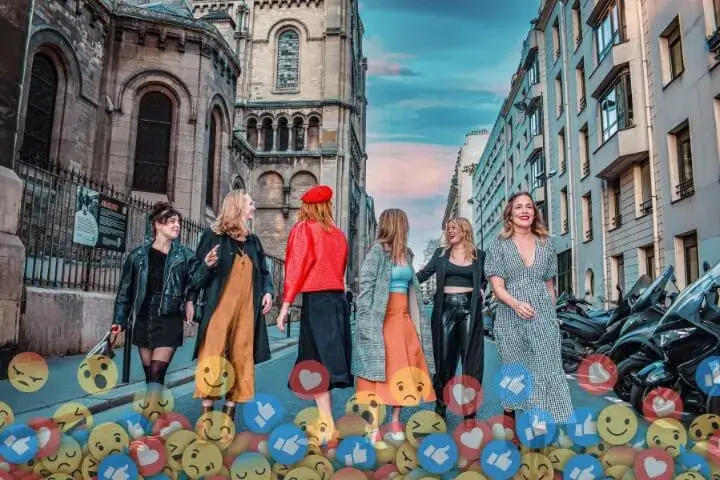The luxury fashion industry is known for its vibrancy and significant impact and continually shapes conversations across social media platforms. By analyzing mentions and online behavior we uncovered exclusive insights into consumer trends and the industry.
In this article we brought an analysis of the ongoing discourse surrounding consumer behavior within the luxury fashion industry:
- Mention Volume: Examining conversations about Luxury Fashion, identifying peaks and dissecting the factors influencing these fluctuations.
- Demographics: Who are the key players discussing Luxury Brands? What are their professions and interests?
- Dominant Online Brands: Which brands reign supreme in the online landscape?
- Influencers: Who are the celebrities generating the most buzz in Luxury Fashion discussions?
- Concerns and trends regarding the Luxury Fashion Industry and consumption
Understanding the dynamic fluctuations of the luxury fashion industry
In the industry of luxury fashion mention volume is a key indicator of what drives conversations among users. During the periods of September 2022 and 2023 we observed three significant peaks warranting further investigation: September and October 2022, December and January 2023 and September 2023.
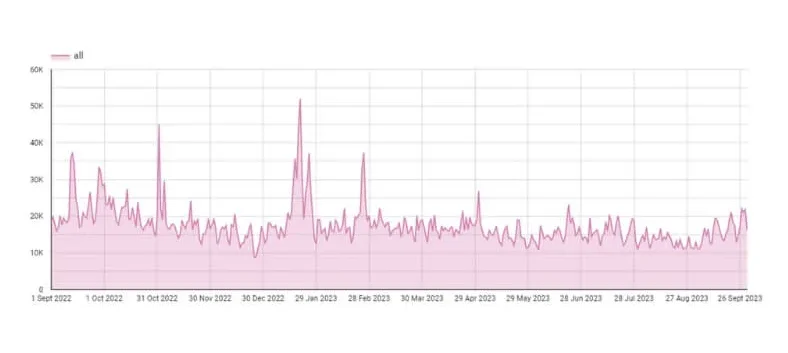

These peaks hint at notable seasonal dynamics suggesting heightened spending during the fall months of September and October and during the holiday season in December and January leading to a surge in mentions at the onset of 2023. Next a gradual decline occurred in the ensuing months likely due to post-holiday lulls and economic constraints.
It’s essential to maintain awareness of the local and global context when conducting analyses since it provides great insights into online consumer behavior and the potential influence of economic factors.
Reaching peaks during the fall of 2022 and 2023 the mention volume of conversations surrounding luxury brands hints at notable seasonal dynamics. These fluctuations offer a window into consumer spending habits influenced by events like the holiday season and economic trends. Understanding these patterns is super important for brands aiming to connect with their audience effectively.
Recent economic uncertainties including inflation and global fiscal policies have reshaped consumer spending in luxury fashion. Our analysis delves into how these factors influence consumer sentiment driving a shift towards more conservative spending and impacting luxury fashion purchases.
Trends in fashion consumption
A closer examination of the content within these mentions reveals the products that dominate consumer discussions. Clothing, bags and accessories take center stage. With the first one being the most prominent category and alining with brands’ emphasis on clothing in advertising, events and stores.
According to a 2021 report by Luxury Daily the global luxury fashion market experienced a significant surge in demand for high-end apparel with luxury clothing accounting for a big portion of overall sales.
Conversations also touch on topics such as jewelry, shoes and makeup even if less frequently. These discussions potentially indicate audience interest and investment opportunities.
A study by McKinsey & Company in the same year emphasized the enduring appeal of premium accessories including bags and other fashion items which consistently contribute to the revenue of luxury brands. Reinforcing the importance of accessories in shaping consumer preferences and market trends.
In 2022 an analysis by Vogue Business highlighted the steady growth of the luxury footwear market with an increasing demand for premium shoes among affluent consumers. This reaffirms the significance of shoes within the luxury fashion industry reflecting the enduring enthusiasm for exclusive and high-quality footwear which in turn influences luxury brand discussions and consumer behavior
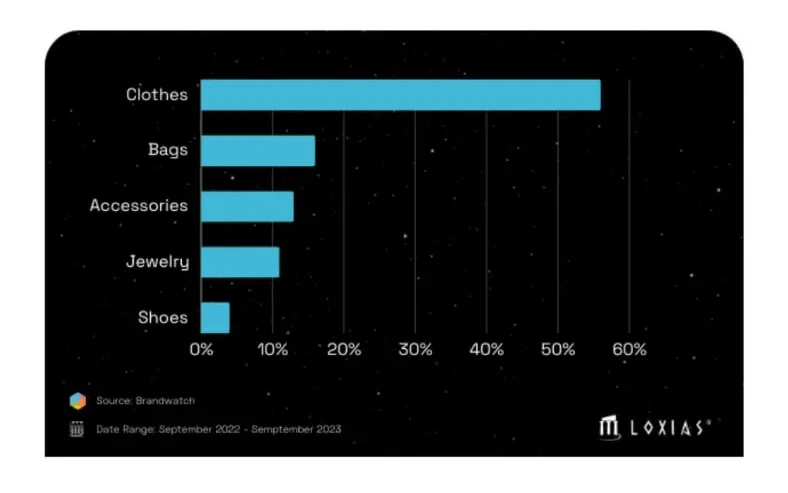

Top Interests and Professions
Understanding the individuals driving these conversations makes a huge difference. Who are they? What are their daily habits and interests? What defines their lives? These questions offer brands insights into their audience enabling the creation of highly targeted marketing campaigns that resonate with consumers’ preferences and establish stronger connections.
Within the luxury fashion sector predominant interests include sports family and parenting, music, books and games. These diverse interests reach various age groups allowing luxury brands to explore creative avenues in their marketing efforts.
The connection between sports and fashion while initially unconventional has a long history. luxury brands frequently engage in sport-related partnerships. The collaboration between Louis Vuitton and the NBA in 2020 sets a great example.
In 2023 this tendency gained even more momentum resulting in a large amount of partnerships between luxury brands and athletes.
Trends like “Blokecore” exploded online, making luxury brands target athletes as influencers, muses or brand ambassadors.
Notable collaborations include Burberry’s partnership with the soccer-inspired lifestyle brand Able Made, Gucci teaming up with tennis player Jannik Sinner and Prada becoming the official partner of China’s Women’s National Football Team, among others.
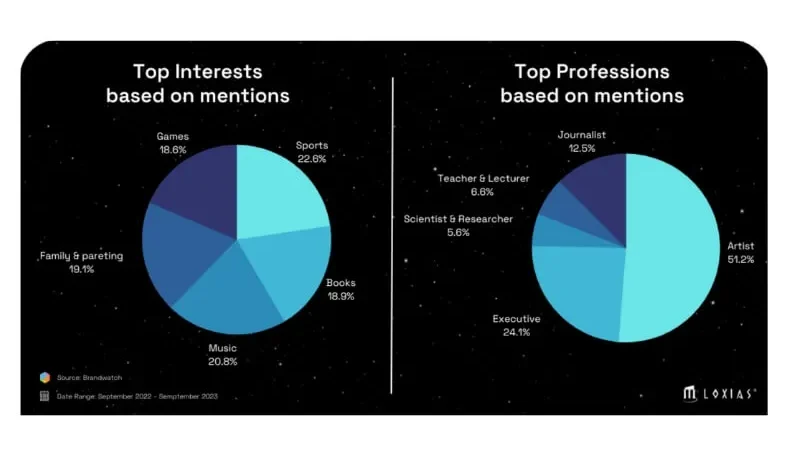

An examination of top professions reveals the presence of professionals in fields such as “Artist” and “Journalism” underscoring the active promotional and media landscape surrounding luxury products. This presence significantly influences discussions and perceptions of luxury goods.
The Most Discussed Brands: Gucci, Louis Vuitton and Chanel
These three brands have dominated online conversations in 2022 and 2023 beating their competitors by far.
Gucci’s resurgence in recent years under the creative direction of Alessandro Michele has renewed its brand image by blending eclectic designs with a modern edge. Gaining a lot of attention from millennial and Gen Z consumers.
Louis Vuitton with its rich heritage and strategic collaborations with notable artists and designers has solidified its position as an emblem of sophistication and exclusivity catering to an audience that values tradition and class.
Dior on the other hand continues to draw from its storied past creating collections with an elegant yet contemporary flair. This appeals to those seeking timeless, refined luxury.
Collectively these brands’ distinct yet complementary approaches have brought them to the top of fashion discourse reflecting their enduring influence and appeal across diverse consumer demographics.
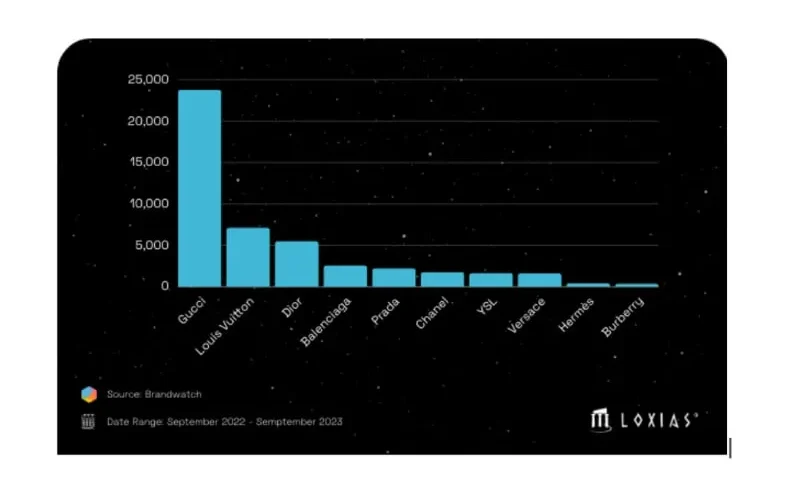

Generational Influence on Conversations
When it comes to Luxury Fashion Millennials dominate online conversations. The significant engagement of this generation in this market is influenced by various factors including their purchasing power. Generation Y being older and typically having more established careers takes the lead over Generation Z. They also outperform Generation X since they usually are more active internet users.
We can assert that Millennials are the primary trendsetters in the luxury market. Their preferences and opinions exert a significant influence on how brands act.
Generation Z has also been emerging as a significant contender. Demonstrating a growing impact on the luxury fashion industry. Their strong emphasis on digital fluency and authenticity positions them as critical drivers of change steering the conversation toward more innovative and inclusive fashion trends.
While Generation X remains engaged their relatively lower participation suggests a slightly diminishing influence compared to the younger demographics highlighting the evolving dynamics and preferences within the luxury fashion sphere.
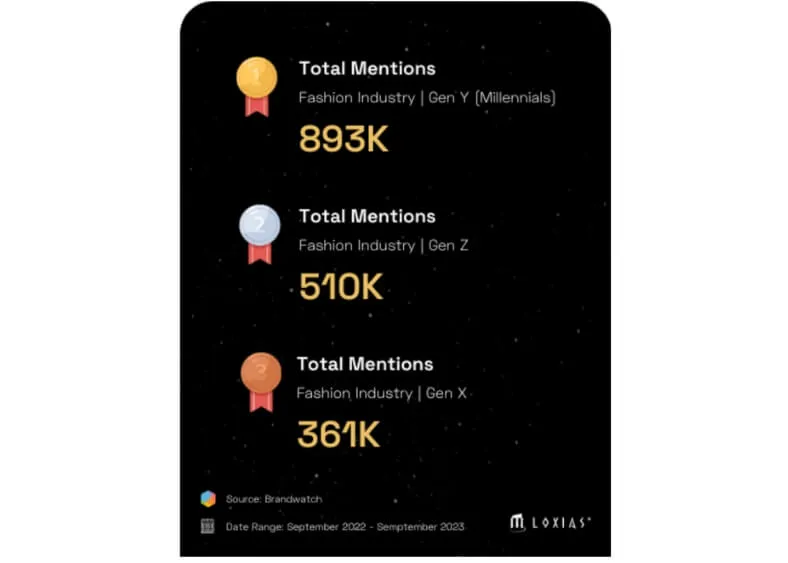

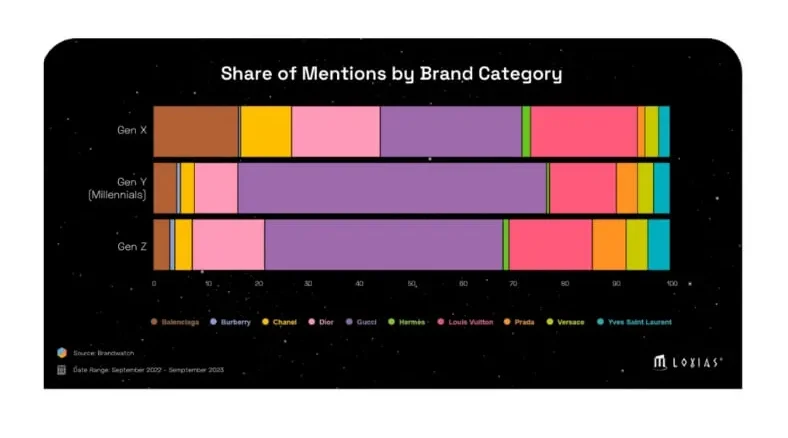

Regardless of age Gucci consistently maintains a high level of interest indicating its enduring appeal among various demographic segments. Dior’s increasing engagement over time suggests a growing resonance with Generation X, possibly owing to successful marketing campaigns or product innovations tailored to their preferences. Louis Vuitton’s stable engagement reaffirms its enduring popularity and timeless appeal within this demographic. Balenciaga’s fluctuating engagement may be attributed to the brand’s dynamic and evolving approach resonating with different segments of Generation X throughout the analyzed period. Versace and Yves Saint Laurent’s upward trends indicate a rising interest in these brands among Generation X possibly influenced by successful product launches, collaborations or cultural relevance.
In contrast Burberry’s relatively lower engagement signifies the need for potential revitalization to better capture the attention and interest of Generation X consumers.
The Impact of Brand Ambassadors for Luxury Brands
The association of luxury brands with influential public figures has long been a common strategy in the fashion industry. In recent years, a consistent trend has emerged: numerous luxury brands partnering with K-pop stars. It became even more pronounced in 2022 and 2023 with notable examples like Jennie from the group BlackPink, who went as a Chanel Ambassador at the Met Gala becoming one of the most discussed topics on the internet.
With the immense global growth of the South Korean pop industry brands have recognized significant opportunities to expand their audience and generate more online buzz. According to Statista by December 2022 K-pop was considered very popular worldwide by over 45% of respondents.
This popularity is driven by dedicated fans who actively engage and consume content related to these artists. Once again the importance of brands staying attuned to online trends becomes evident. The fashion industry has realized that working with these stars can provide various advantages and significantly increase their reach.
Dior highlights Jisoo’s role at the Lady Dior celebration event. She’s a BlackPink member and a global brand ambassador.
Accompany global fashion and beauty ambassador, JISOO, at the #LadyDior Celebration in Seoul, exuding elegance in a froissé fabric dress with leopard print patterns by Maria Grazia Chiuri and her #DiorAW23 Lady Dior bag. Follow https://t.co/8o7StckEzv for more updates. pic.twitter.com/37ncyyI78D
— Dior (@Dior) September 5, 2023
Loewe unveils its global ambassador and NCT group member, Taeyong, as the cover star of ELLE magazine.
Embaixador global da marca TAEYONG na coleção Outono Inverno 2023 da LOEWE para a ELLE Coreia.
Fotografia Yoon Ji Yong
Estilo Kim Youngjin #LOEWE pic.twitter.com/YieQ9WOgBc— LOEWE (@LoeweOfficial) 10 de setembro de 2023
A complexa interação entre prestígio, ética e inovação na indústria da moda
Enquanto alguns indivíduos aspiram possuir itens de luxo como símbolos de sucesso e status social, outros expressam preocupações sobre consumo conspícuo e materialismo frequentemente associados à busca por bens de luxo. Apesar do fascínio do luxo, há uma crescente conscientização sobre práticas éticas e sustentáveis no consumo de moda. Referências a preferências por itens usados e uma mudança do consumo conspícuo para uma apreciação do artesanato e da qualidade em vez de exibições ostentosas de riqueza são evidentes.
O discurso em torno da moda de luxo ressalta a relação intrincada entre o comportamento do consumidor, os valores sociais e a dinâmica em evolução da indústria da moda. Ele reflete tanto o apelo aspiracional quanto o escrutínio crítico que as marcas de luxo e seus consumidores enfrentam na sociedade atual. À medida que a conversa em torno de práticas sustentáveis e consumo ético ganha força, a indústria da moda de luxo continua a navegar no delicado equilíbrio entre opulência, responsabilidade e inovação.
So what is the future of luxury fashion?
This industry stands at a juncture shaped by dynamic consumer behaviors, technological advancements and a growing emphasis on sustainability and ethics. Our analysis reveals a landscape rich with opportunities and challenges. Established brands continue to hold sway yet emerging labels and digital-first strategies are significantly altering the market dynamics.
In this era the key to success lies in understanding and adapting to these evolving trends. Brands must get the delicate balance between heritage and innovation, exclusivity and accessibility, tradition and trendsetting. As digital platforms become increasingly central to marketing strategies the importance of authentic engagement and storytelling emerges as a crucial differentiator.
Brands that are agile, customer-centric and value-driven will not only thrive but also redefine the standards of the industry. For marketers understanding these nuances and leveraging data-driven insights will be essential in crafting strategies that resonate with contemporary consumers and sustain long-term growth.
We have more insights for you!
By blending AI and human intelligence we harmonize the strengths of both delivering complete analyses packed with unique data. Loxias tools to identify patterns and trends such as popular products or brand preferences. If maintaining your company’s positive online reputation is your goal we can definitely help. All this is made possible through real-time data analytics and monitoring.

